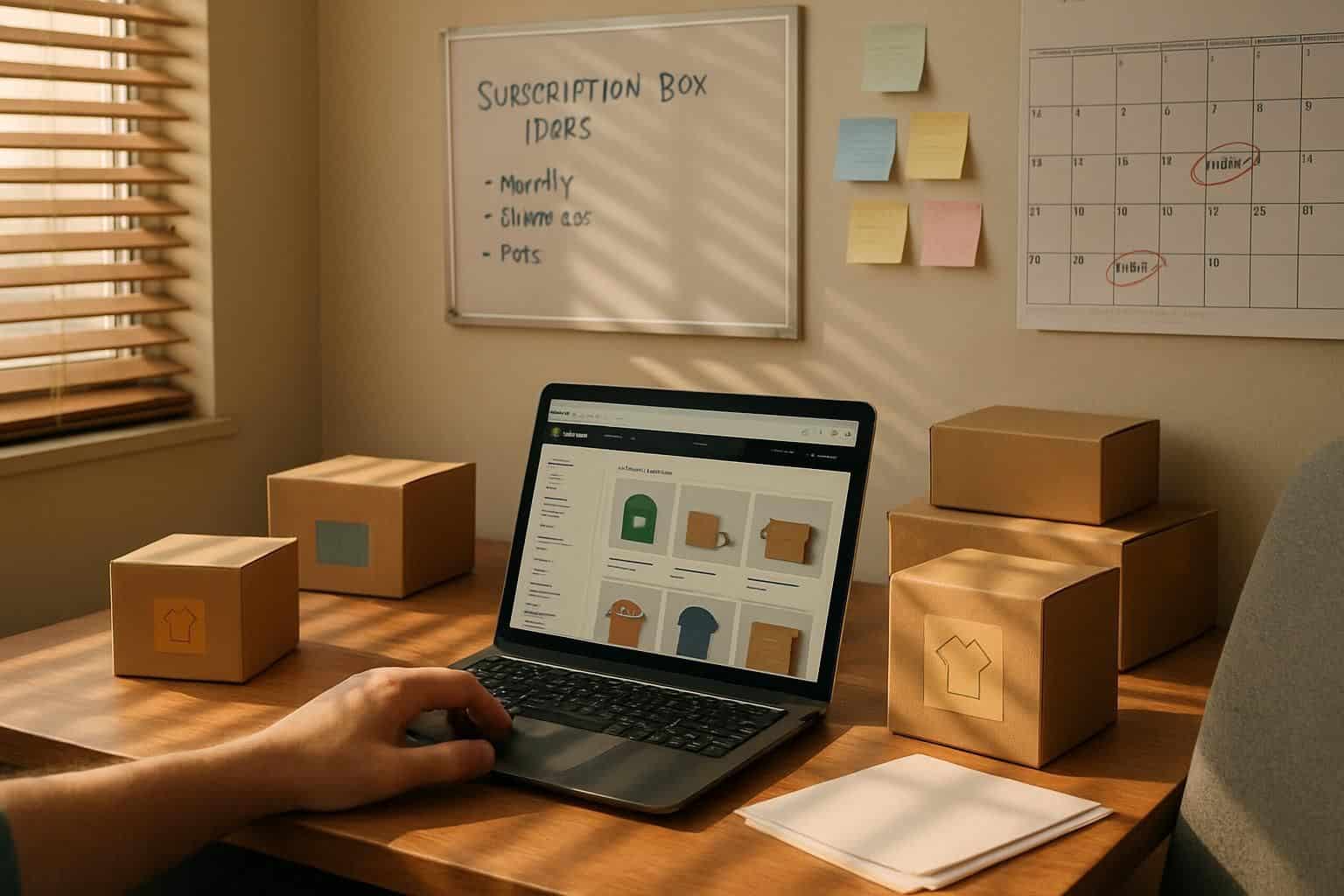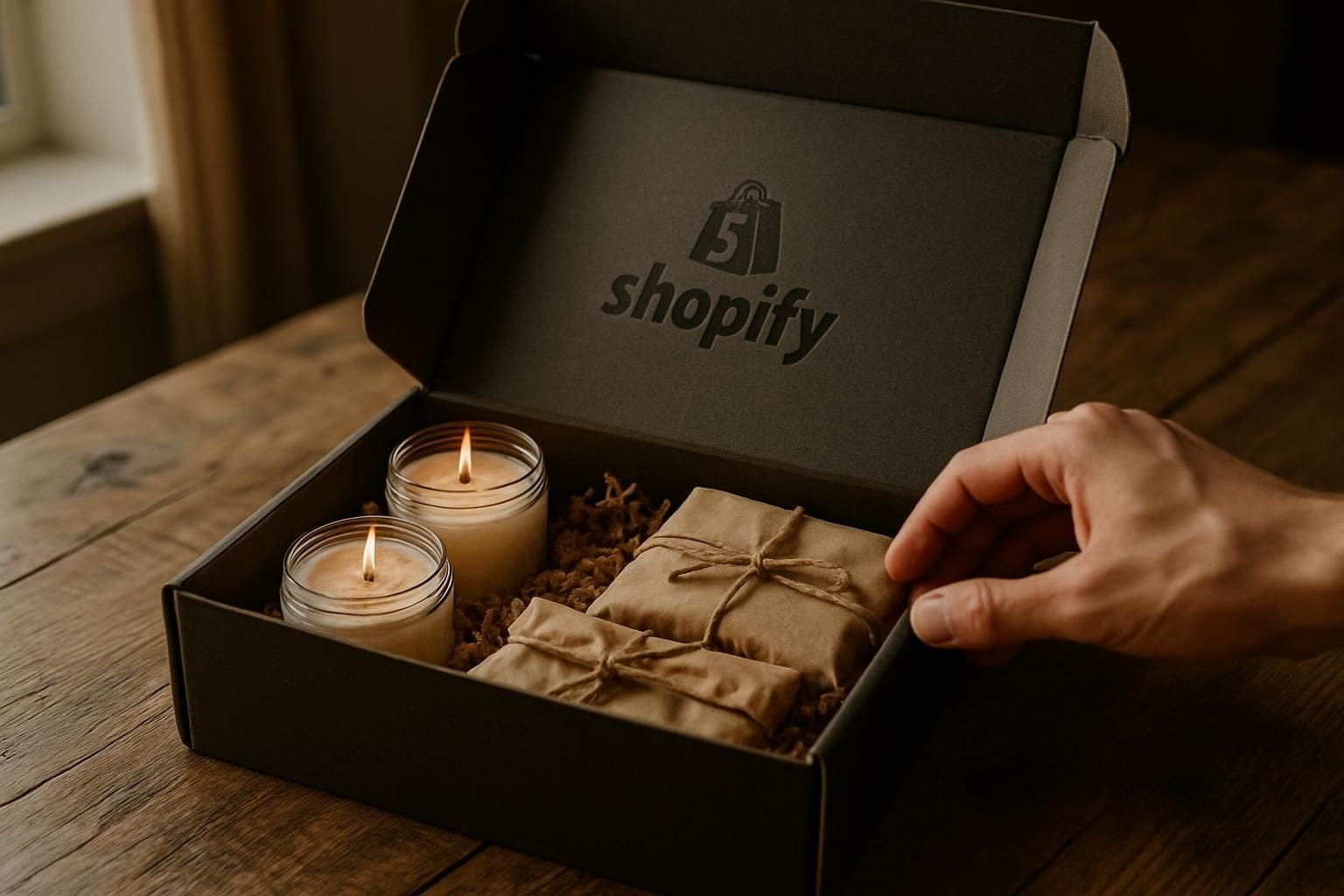Many entrepreneurs want to know how to start a subscription box business with Shopify but don’t know where to begin. The subscription box market expects growth up to $2.3 trillion by 2028, showing huge potential for your online store.
This guide gives you 7 clear steps, from choosing products and pricing strategies, to using Shopify apps and helpful marketing tips. Read on to build a profitable subscription service in 2025.
Key Takeaways
Subscription boxes are booming right now—expected to hit $2.3 trillion by 2028. Prices usually go between $15 and $100 per month, giving sellers steady monthly revenue.
Pick your style from four main subscription types: curation boxes (think Birchbox), replenishment boxes for everyday items, access boxes offering special discounts, or hybrid models mixing subscriptions and one-time buys.
Aim for about a 50% profit when pricing. Consider offering several price levels like Basic, Premium, and Luxury to give customers choice, fitting different budgets.
Easily add subscriptions to your Shopify store by using apps like Appstle, Seal, or Bold Subscriptions. They help manage recurring billing and customer accounts smoothly.
Keep subscribers loyal by tossing in surprise gifts, keeping policies simple and clear, and giving personalized options—36% of buyers like products customized just for them, and they’re willing to pay extra.
Table of Contents
Understanding the Subscription Box Business Model

Subscription box businesses thrive on sending products to customers on a set schedule. These boxes create steady income for sellers while giving buyers fresh items without the hassle of reordering.
Key features of subscription box businesses
A subscription box company sends carefully chosen items right to customers’ doors on a regular schedule. Customers pay between $15 and $100 each month, bringing in steady, predictable income.
According to top Shopify SEO experts, repeat shoppers spend as much as 67% more compared to new buyers. Plus, box services save money by ordering inventory early, usually in bulk, cutting down costs overall.
The magic of subscription boxes lies in turning one-time shoppers into loyal fans who open their wallets month after month.
Winning boxes use surprises, quality products, and creative themes to match customer tastes. And the unboxing part really counts—with custom boxes, special notes, or personal touches that boost excitement about each delivery.
Products that people run out of often—or hobby gear that customers love exploring—fit this approach well. Predictable income makes it much easier to plan finances and grow smoothly compared with regular stores.
Types of subscription business models: Curation, Replenishment, Access, Hybrid
Subscription models help businesses serve customers better, keep them happy, and boost profits. There’s a perfect fit for every store type and product you’re selling:
- Curation model: Companies like Birchbox and Stitch Fix send customers hand-picked products based on personal tastes. Great for food, clothing, beauty items—anything that needs careful selection.
- Replenishment model: Sends regular deliveries of items people always need, like razors, vitamins, or pet food. Helps customers avoid frequent shopping trips or suddenly running out of essentials.
- Access model: Brands such as JustFab, NatureBox, and Amazon Prime offer members exclusive deals, discounts, or free shipping. Customers pay a membership fee and enjoy special savings or members-only products.
- Hybrid model: Smart brands combine subscription sales with one-time buys. They gain extra sales, reach new customers, and test new items through subscriptions.
- Indigenous Box: Mallory Yawnghwe created a subscription box focused on Indigenous-made goods. This is a great example of the curation model supporting cultural creators.
- Kombucha Subscription: The Lockerbies launched subscriptions to sell their organic kombucha and secure steady monthly income. Even small brands can easily use subscriptions to help their business grow.
Choosing the best subscription model depends on your Shopify store products and your customer base.
Determining If a Subscription Model Is Right for Your Business

Not every product works well as a subscription. Check if your items have repeat purchase potential and if your target market wants regular deliveries.
Assessing your product’s suitability
Your product needs to clear a few key checks before making it into a subscription box. The best options? Items people buy regularly—coffee, snacks, skincare products, stuff like that.
Make sure your item addresses a frequent issue or fulfills a common need. Great subscription products offer convenience, the fun of discovery, or cost savings. Check out your audience’s buying patterns.
Are they already picking up similar products every month? High-margin products work better here—you’ll want room in your budget for packaging, shipping, and marketing. Start small.
Run your idea by a select group first, just to see responses and gather quick feedback before going big.
Evaluating market demand
Market demand shows if people really want what you’re offering. Google Trends helps you see what’s popular at the moment. Amazon and Etsy show you exactly which products sell best.
The data is clear—subscription boxes will grow a lot, from $326.44 billion in 2024 to about $539.16 billion in 2025. That’s a huge jump—around 65.2%! Experts even say it’ll reach $2.3 trillion by 2028.
Smart sellers study trends closely before launch. They test smaller batches first, checking interest and gathering real customer feedback.
Personalization options for your product
Shopify makes it easy to offer personalized subscription boxes your customers will love. Let subscribers pick their items, select convenient delivery dates, or choose options like size, color, and themes.
Stats prove this strategy works—36% of shoppers prefer products made just for them, and half willingly wait extra time for custom orders. Successful brands often use quick quizzes to match subscribers with the ideal items.
Small details, like offering sample boxes or letting customers build their own bundles, make each delivery special.
Personalization isn’t just a feature, it’s the future of subscription commerce.
Tailored boxes also help your bottom line. Customers tend to spend more on personalized orders, returning each month eager to see what’s new. Shopify’s handy apps help you put together unique packages, smart product bundles, or sample box sets.
Tech-friendly shoppers especially love customizing products—it’s interactive, fun, and encourages sharing boxes they receive on social media.
Developing a customer retention strategy
Customer retention is key to any subscription box service. For profitability, aim for a customer lifetime value at least three times your acquisition costs. Start with automated emails—send quick, timely reminders right before renewal dates.
Also, think about setting up a rewards program. Give subscribers points, special items, or early product access at key subscription milestones. Keep a close watch on churn rates, too—catching small issues early helps prevent bigger headaches later.
Getting ongoing customer feedback keeps your subscribers satisfied. After the third delivery, send a short survey about the items and packaging. Use that feedback to quickly adjust and improve future boxes.
High turnover is a big reason many subscription box companies fail. Small, personal details—like handwritten thank-you notes or surprise freebies—can make customers feel valued and stick around longer.
Adjust your retention strategy regularly, based on subscriber behavior and market shifts.
Steps to Start a Subscription Box Business with Shopify

Let’s get into the practical steps to set up your subscription box business on Shopify – from picking your niche to launching your store… keep reading to learn our seven-step process that will help you start earning monthly income in 2025.
Step 1: Choose your subscription box idea
Your subscription box idea sets up the whole business. Aim for something you’re excited about, but check if people actually want it. The market for subscription boxes is growing fast—expected to hit $64.1 billion by 2027.
Top-performing areas include food, beauty, and meal kits. Take time to research social media, forums, and check out competitors. Niche markets can mean fewer rivals and better prices.
The right subscription box idea balances your passion with profit potential.
Think clearly about who your customers are, what annoys them, or what makes them happy. Your box could solve their problem—or just brighten their day. Before going big, run a quick test with a small group.
Make your offering clear right away: customers need a good reason to pay every month. The best boxes give buyers something special, stuff that’s hard to find anywhere else.
Step 2: Select and curate your subscription products
You’ve settled on your subscription box idea—great! Now comes the fun part: choosing amazing products that’ll impress subscribers. Picking the right items is key—it shapes the whole customer experience.
The perfect mix creates loyal fans who happily renew month after month.
First step: find dependable suppliers. Especially true for boxes like beauty, food, or clothing—you’ll need fresh, high-quality goods that truly surprise and delight. Aim for a balanced mix: familiar favorites, plus unique new finds your audience will genuinely enjoy.
A tip many successful box owners use is teaming up with smaller brands—this can mean one-of-a-kind items at friendlier prices. Give each product a personal try before including it—this extra care reassures your customers and boosts repeat business.
For tech boxes, pick a smart combo of exciting gadgets and useful accessories. Strike the right balance—innovative gear plus practical items your subscribers can use every day.
Step 3: Price your subscription offerings
Picking great items for your subscription box matters—but pricing them well is even more vital. Setting the right price decides whether your business thrives or falls flat.
Aim for about a 50% profit margin—this way, the business earns money, and your customers still get value. So, if your box costs $20 to put together, set the price around $40.
Try tiered pricing, too, since different people prefer different options. For instance, offer a Basic option at $25, a Premium choice at $40, and a Luxury version at $60. Clearly outline all costs in your calculations—products, packaging, and payment processing fees.
This helps you quickly check profits and change prices if needed.
Making sure your price covers costs, but also feels affordable to your customers, is key.
Step 4: Create and set up your Shopify store
Now that you’ve set your subscription prices, it’s time to create your online store. Starting a Shopify store is pretty straightforward—and it doesn’t take long, either. First, you need to buy a domain name that fits your brand.
Then, create your Shopify account and choose a theme you really like. On your homepage, use crisp photos and clear descriptions to highlight your subscription boxes.
Your store design is the digital packaging for your subscription business – make it count.
Getting your Shopify store right is simple—but still important. To handle recurring payments smoothly, use subscription apps like Bold Subscriptions or Recharge. These apps do a better job at subscriptions than Shopify’s basic options.
Write clear, persuasive product pages and include good SEO, helping customers easily find your products—especially when compared to options like WordPress.
Keep your checkout quick, clear, and easy to understand, briefly showing how your subscriptions work.
Step 5: Add subscription functionality using Shopify apps
Setting up subscriptions for your Shopify store is easy—just pick the right apps. First, connect your shop to a payment gateway. Then grab a subscription management app such as Appstle Subscriptions & Loyalty, Seal Subscriptions, or Bold Subscriptions.
These tools handle recurring billing, flexible plans, and manage customer payments. Prices and options vary by app—so choose what matches your budget and business goals. Most apps even let customers skip orders, swap items, or cancel subscriptions whenever they want.
Your subscription tool should also collect customer info and spot trends. Good analytics can show churn rates clearly, helping you hold onto existing subscribers—it’s cheaper than getting new ones, after all.
Be sure the app works smoothly with your store’s theme and your current software stack.
Step 6: Develop a robust subscription policy
A clear subscription policy keeps your business safe, while building trust with customers. It should plainly cover billing cycles, payment terms, and cancellation guidelines. Shopify makes creating policies easy—just head to the admin panel, then click Settings > Policies.
They even provide ready-made templates you can tweak to fit your needs.
Keep the wording simple and clear. Explain exactly what happens if someone misses a payment, asks for a refund, or if you change your products. Lots of subscription box owners overlook this—but it matters for legal protection, and it keeps customers happier.
Think of your policy as an agreement between your business and your subscribers, so write it carefully. Being upfront helps cut down conflicts and keeps people subscribing longer.
With your policy sorted out, you’re ready to launch your subscription box confidently.
Step 7: Launch your subscription box business
Launch day is the payoff for all your hard work—your subscription box business is finally open! First thing: submit your sitemap through Google Search Console. This speeds up Google indexing, so customers find you sooner.
Next, add Google Analytics to your site so you can see visitor numbers, behavior, and traffic sources. It highlights the marketing moves that really pay off.
Clearly explain your subscription terms to avoid surprises. Include info about billing cycles, cancellation rules, and exact shipping timelines. Lots of Shopify stores fail early by skipping clear policies.
Make launch day memorable for your first customers—maybe offer a nice discount, or toss in a free gift. Little details like these help turn curious customers into dedicated subscribers.
Optimizing Your Shopify Subscription Box Business

Your subscription box success depends on smart marketing and store design. Learn key growth tactics to boost sales and keep customers coming back for more.
Use marketing strategies tailored to your target audience
Focus marketing efforts on the right tech-savvy crowd for your subscription box. Social media ads, influencer collabs, and personalized emails usually get the best response from geeks.
Word-of-mouth alone drives around $6 trillion each year in sales—that’s 13% of total purchases. Check analytics regularly, see what’s clicking with your audience.
Consider doing A/B tests on landing pages, you’ll likely see more sign-ups. Create content that directly addresses what your tech fans care about—solve what bugs them. Using data in marketing helps you stretch your budget and improve outcomes.
Build an online community around the box: forums, social media groups, or virtual events. Let subscribers openly share unboxing videos and chat about their experiences.
Create an engaging and informative landing page
Your landing page is like your business’s front door—it welcomes customers and shows what you’re all about. Custom landing pages can boost sign-up rates by 40%, with clear messages that directly appeal to your target buyers.
Plus, adding a simple FAQ section covering things like shipping details, billing, and cancellation terms helps build trust with visitors.
Try testing different headlines or buttons because data shows pages with A/B testing convert up to 25% better. High-quality product images, short customer reviews, and a quick sign-up form make joining easy and fast.
Even better, Shopify’s simple page builder helps you create mobile-friendly pages without any coding—super user-friendly for beginners.
Special offers like “Get 15% off your first box” encourage more visitors to become subscribers. Your landing page needs to explain the value clearly within just a few seconds—since people usually decide to stay or click away in about 8 seconds flat.
Show the excitement of opening your box through fun videos or photos. Clearly list what’s inside or tease surprise items to intrigue your audience. Also, make your main selling point obvious, like eco-friendly packaging, rare finds, or expert-picked items.
The best pages load quickly, look good on phones and computers, and make it easy to know exactly what to do next.
Utilize third-party tools for better subscription management
Third-party tools can really simplify managing a subscription box business. For example, apps like Appstle Subscriptions & Loyalty, Seal Subscriptions, and Bold Subscriptions handle boring tasks—billing, renewals, and customer management.
Appstle offers a free plan until you reach $500 per month in subscription sales, after that, paid plans kick in at just $10 monthly. Plus, these apps handle inventory tracking, so you won’t unexpectedly run out of products.
Seal Subscriptions provides flexible options to automate billing and customer accounts—saving you hours weekly. Smart subscription management tools spot customer trends early, helping you pick popular items for upcoming boxes.
Good management tools can reduce canceled orders and increase steady revenue, all while making the whole process simpler.
Surprise customers with occasional gifts or perks
Boost customer loyalty by slipping surprise gifts into your subscription boxes. Small gestures—stickers, product samples, even discount coupons—heighten the excitement of the unboxing moment, turning subscribers into loyal fans.
GreenUp Box does this really well, tossing surprise eco-friendly goodies into their quarterly and yearly boxes. These unexpected extras offer customers more than their money’s worth and leave them feeling special.
Bonus items don’t have to break the bank either; even quick handwritten notes can boost retention.
Smart subscription companies think carefully about timing these perks. Holidays, anniversaries, and right before someone thinks about canceling—all ideal moments to sprinkle in extra treats.
Keep track of which surprises spark the most buzz on social media—this helps you choose future bonus items. The main aim is simple: give customers a feeling they’re getting extra value every single time.
Examples of Successful Shopify Subscription Box Businesses

Shopify powers some of the most impressive subscription box success stories in today’s market. Check out these three brands that turned simple ideas into thriving subscription businesses with loyal customers and steady growth.
Joshua Tree Coffee
Joshua Tree Coffee Company is a great example of subscription success on Shopify. Their Coffee Club has gained over 3,800 positive customer reviews—people love getting freshly roasted beans delivered right to their homes.
The company roasts organic coffee beans in small batches to maintain high quality. Plus, they offer different plans, letting customers choose exactly how much coffee they get and how often.
Through the subscription model, Joshua Tree Coffee builds strong, lasting relationships with coffee drinkers. Subscribers get extra perks too, such as early tastes of new flavors and helpful brewing tips.
Their easy-to-use online store even lets subscribers manage their plans with just a few clicks. The smart system brings in steady sales, making inventory planning much simpler. Coffee drinkers enjoy the steady, reliable quality—and love getting premium coffee delivered without stepping outside.
John’s Crazy Socks
John’s Crazy Socks is a standout Shopify subscription success. The father-son duo runs a social enterprise called the Sock of the Month Club—earning over 20,000 glowing reviews. They give back too, donating 5% of profits to the Special Olympics.
To manage recurring orders easily, they rely on the Bold Subscriptions app on Shopify. Their success proves even simple products like socks can win loyal customers—through high quality, a meaningful mission, and smart tech tools.
Now, let’s check out another subscription box business that’s thriving in its own special way.
GreenUP Box
GreenUP Box is making waves in the subscription market—with eco-friendly collections people actually want. Run on Shopify, it offers quarterly and annual subscriptions, rewarding customers who stick around with solid savings.
They’re thriving because they know how to keep customers engaged, curating fresh, unique packages perfect for people who care about sustainability but dislike long hours of research.
Every box revolves around one single eco-friendly theme, with practical items handpicked to fit. GreenUP Box has built a strong, loyal following by taking all the stress from product discovery, helping subscribers live greener lives without extra hassle.
Smart inventory planning means products stay fresh and new every quarter—keeping everyone curious and eager for the next box, while also increasing subscriber value.
Tips to Grow and Sustain Your Subscription Box Business
Growing a subscription box business needs more than just great products. Smart growth tactics and a focus on keeping customers happy will turn your box service into a money-making machine.
Build a loyal community around your brand
Building loyalty means creating a community around your subscription box. Try setting up private subscriber groups on social media, where fans can share tips, post pictures, and just hang out together.
Our data found brands with active groups had 40% higher loyalty from customers. Consider starting an ambassador program too—reward your most enthusiastic subscribers with points, free products, or even cash for referring friends.
Each month you can spotlight 3-5 super fans on your social media pages, building stronger bonds and turning satisfied customers into vocal supporters. And here’s a good tip: Targeting a specific audience often works better than pleasing everyone.
GreenUP Box, for example, increased its subscriber base by 78% in only 6 months after focusing on eco-conscious tech workers, using custom packaging and online events to attract them.
Focus on customer retention and engagement
Keeping existing subscribers happy costs much less than finding new ones. Smart subscription box brands pay attention to customer preferences, then send items customers actually love.
Our data shows loyalty programs increase retention by around 30%, and personalized emails boost engagement by about 25%. Set automatic check-ins at the 3-month, 6-month, and 12-month marks to gather quick feedback.
Then use that feedback—to solve issues early and improve your boxes each month. Shopify tools like Smile.io let you easily set up reward programs, encouraging customers to stay longer.
The experience of opening your box matters just as much as the items inside. Even small touches like handwritten notes, surprise gifts, or special exclusive offers make customers feel appreciated.
Many successful subscription brands also build online groups, where subscribers share pictures, ideas, and product tips. This kind of social interaction creates fans out of casual shoppers, making them stick around longer.
So here’s a quick peek at a few subscription box successes on Shopify.
Continuously improve your offerings based on feedback
Strong customer connections mean better products. Your subscription box should change based on user feedback. After each box ships, send out quick surveys to gather direct input. This simple move helps you catch trends early, solve issues fast, and stay sharp.
Our data shows boxes that reflect customer feedback have a 40% higher renewal rate.
Prototype boxes let you test ideas before going big. Send trial boxes to small groups, and listen carefully—about items, packaging, even the unboxing vibe. Early checks help fix mistakes cheaply and quickly, before larger production runs.
Popular companies like GreenUP Box often test three or four versions with small focus groups first. Doing this avoids waste, saves costs, and delivers exactly what customers want.
How Will the Subscription Box Landscape Evolve in 2025?
The subscription box market will reach $40 billion by late 2025—opening huge opportunities for Shopify sellers. Customers will prefer boxes they can customize to their tastes and lifestyle, not just boxes filled with random items.
Savvy brands will use better market research to target small yet eager customer groups that others overlook. Successful boxes will blend AI tech and personal details to create an experience that’s unique for each buyer.
Pricing will evolve—expect more flexible options like “skip-a-month” or loyalty perks that keep improving with time.
Behind the scenes, tech will upgrade how subscription boxes function. Inventory systems will become smarter, cutting down on excess waste. Packaging will grow more eco-friendly, driven by shoppers’ desire to reduce plastic use.
Social proof will become key—authentic customer videos of box openings will matter more than paid commercials. The legitimacy of digital marketing will rely on genuine feedback and proven outcomes.
Boxes that address real-life needs—instead of just offering trendy items—will earn long-term loyalty.
People Also Ask
What is a subscription box business model?
It’s a business setup where customers regularly pay a fixed fee, usually monthly, for a box of curated items. This structure keeps revenue steady and encourages repeat buyers.
How can Shopify help me start a subscription box business?
Shopify offers easy-to-use subscription apps in its store—making recurring billing simple. It handles inventory, builds your website, and tracks customer trends, all in the same platform. Plus, you can predict sales better and keep your profits balanced.
What should I include in my market research?
Check your target customers and their preferences clearly. Look at competing subscription services—grocery or streaming boxes—to find inspiration. Pinpoint what makes your product different, so customers prefer you over another service.
How do I build customer loyalty for my subscription service?
Make the unboxing fun, add personal touches, and create a sense of community. Keep customers connected with friendly email updates. Strong interaction at every customer touchpoint strengthens brand loyalty and boosts how much your subscribers spend over time.
What marketing strategies work best for subscription boxes?
Social media and influencer recommendations usually work great. Keep your ads simple and clearly focus on your main selling point. Use content designed to reduce how much you pay to gain each new customer.
How much investment do I need to start?
Begin small—use a basic product offering to see if customers like your idea before you spend big. Factor in costs like supplies, stock handling, and website creation upfront. Many successful subscription companies started with affordable tests and then expanded after proving their idea worked.
References
https://the4.co/blogs/shopify-tutorials/how-to-start-a-subscription-box-business-with-shopify (2024-08-15)
https://www.shopify.com/blog/how-to-start-a-subscription-business
https://www.shopify.com/blog/product-customization (2025-04-18)
https://www.subbly.co/blog/start-a-subscription-box-business/
https://www.chargebee.com/blog/how-to-start-a-shopify-subscription-box-business/ (2024-09-11)
https://www.loopwork.co/blog/build-shopify-subscription-box-business
https://gempages.net/blogs/shopify/shopify-subscription-box (2024-12-18)
https://elementor.com/blog/start-a-subscription-box-business/ (2025-01-19)
https://www.chargebee.com/blog/how-to-start-subscription-box/ (2024-07-24)
https://www.replo.app/blog/subscriptions-in-shopify-a-complete-guide (2025-01-31)
